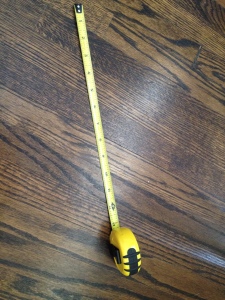What you should know about Square Footage

5 Things to know about Square Footage
I have received calls from buyers and real estate agents complaining about finding out that their home or condominium had less square footage than was represented on their original MLS® listing.
My immediate thought was “did the home shrink after closing?” In other words, if the square footage was really important to you, why didn’t you measure it yourself before you bought the home?
Here are 5 lessons to remember about square footage:
1. When you buy from builder plans, nothing is guaranteed
Some builders attach plans with square footage to their agreements, other don’t. Even if the plan is attached, The Tarion Warranty Programme permits registered builders to make errors up to 2% and unfortunately, there are no penalties if the error exceeds 2%. While buyers can request a price adjustment if the error exceeds 2%, in my experience, most builders will not agree with this. In addition, there is confusion as to whether the measurements are just for interior living space or whether it goes to the exterior walls, and it may not account for pillars or other obstructions inside the unit.
So even if you are relying on builder plans when figuring out the square footage, there may be errors in them.
2. Buyers may be able to sue if the difference is substantial
The case law has gone both ways as to whether a buyer can successfully sue if they find that the seller misrepresented the square footage and the difference was substantial, say over 10%. In some cases the listing brokerage was held responsible for not properly verifying the information. But it is not guaranteed.
3. Will disclaimer clauses protect sellers and real estate salespeople
A disclaimer clause will likely protect a seller from liability, unless they knew the information was false and gave it out anyways. However, a real estate salesperson is required to do their due diligence. That does not mean that you can just copy the square footage from an expired listing. If you do not do any due diligence, you may still have violated the Real Estate Council of Ontario Code of Ethics, even with a disclaimer clause.
4. If you are acting for the buyer, ask how the seller came up with the square footage
While buyer salesperson can normally rely on a listing salesperson to conduct due diligence, it is a good idea to always ask where the number for the square footage came from. Was it on plans, through MPAC or just from a prior MLS® listing when they bought in the first place? In addition, if you see a disclaimer clause, explain this to the buyer and consider having the property measured by the buyer themselves for verification.
5. If you are not sure, just measure it yourself
It is easy to be fooled when it comes to square footage. Professional home stagers are experts at making rooms appear larger than they are by the furniture that is used. If you are acting for a seller, discuss with the seller the advantages of hiring a professional to verify the square footage before putting the home on the market. If you are acting for a buyer, ask them if the square footage is important to them, and if necessary, take the time to do some of the measurements with the buyer to make sure the area is close to what is being represented.
By asking the right questions both before listing and during the offer negotiations, there should be no complaints or claims about square footage after closing.
Content provided by: Mark Weisleider, Partner, Real Estate Lawyers.ca LLP
Email: [email protected]
Website: www.RealEstateLawyers.ca
Direct Line: (647) 497-5706
Toll Free Tel: 1-888-876-5529
Toll Free Fax: 1-855-466-3803
Offices and Mobile Signing Across Ontario
Head Office: 321 Cityview, Unit 3, Vaughan, Ontario, L4H 3S7


You must be logged in to post a comment.